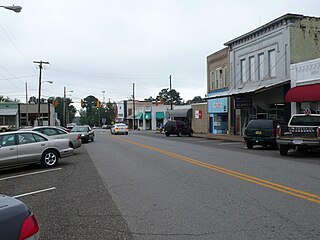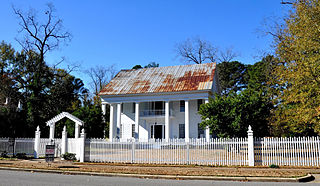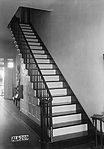
Eutaw is a city in and the county seat of Greene County, Alabama, United States. At the 2020 census, the population was 2,937. The city was named in honor of the Battle of Eutaw Springs, the last engagement of the American Revolutionary War in the Carolinas.

Fort Hill, also known as the John C. Calhoun House and Library, is a National Historic Landmark on the Clemson University campus in Clemson, South Carolina, United States.

For the public official in Idaho see Charles Marshall Hays

Bluff Hall is a historic residence in Demopolis, Alabama, United States. The original portion of the house is in the Federal style with later additions that altered it to the Greek Revival style. It was documented as part of the Historic American Buildings Survey in 1936, and added to the National Register of Historic Places in 1970. It serves as a historic house museum, with the interior restored to an 1850s appearance.

Gaineswood is a plantation house in Demopolis, Alabama, United States. It is the grandest plantation house ever built in Marengo County and is one of the most significant remaining examples of Greek Revival architecture in Alabama.

Rosemount is a historic plantation house near Forkland, Alabama. The Greek Revival style house was built in stages between 1832 and the 1850s by the Glover family. The house has been called the "Grand Mansion of Alabama." The property was added to the National Register of Historic Places on May 27, 1971. The Glover family enslaved over 300 people from 1830 until 1860.

Thornhill is a historic plantation near Forkland, Alabama. The Greek Revival main house was built in 1833 by James Innes Thornton. The house was placed on the National Register of Historic Places on May 10, 1984.

Bermuda Hill, also known as the Liver House, is a historic plantation house in Hale County, Alabama near Prairieville, Alabama. It was added to the National Register of Historic Places on July 7, 1994, as a part of the Plantation Houses of the Alabama Canebrake and Their Associated Outbuildings Multiple Property Submission.
Myrtle Hill may refer to:

The Goode–Hall House, also commonly known as Saunders Hall, is a historic plantation house in the Tennessee River Valley near Town Creek, Alabama. It was added to the National Register of Historic Places on October 1, 1974, due to its architectural significance.

Fairhope Plantation is a historic Carpenter Gothic plantation house and historic district, located one mile east of Uniontown, Alabama, US. The 2+1⁄2-story wood-framed main house was built in the Gothic Revival style in the late 1850s. The plantation historic district includes six other contributing buildings, in addition to the main house. It was added to the Alabama Register of Landmarks and Heritage on December 19, 1991, and subsequently to the National Register of Historic Places on May 29, 1992, due to its architectural and historical significance.

Kirkwood is a historic plantation house in Eutaw, Alabama. The house was recorded by the Historic American Buildings Survey in 1934 and by Carol M. Highsmith in 2010. It was placed on the National Register of Historic Places on May 17, 1976, due to its architectural significance.

The John Coleman House, also known as Grassdale, is a historic plantation house in Eutaw, Alabama, United States. The two-story wood-frame I-house was built by John Coleman from Edgefield, South Carolina, on property that he settled in 1819. Coleman held 75 slaves during the 1840 United States Census of Greene County. The house was placed on the National Register of Historic Places as part of the Antebellum Homes in Eutaw Thematic Resource on December 6, 1982, due to its architectural significance. Coleman family members, as well as many slaves, are buried in a cemetery close to the house. The house is currently used as a hunting lodge.

The Dr. Willis Meriwether House, also known as the Clark-Malone House, is a historic vernacular Greek Revival style house in Eutaw, Alabama, United States. The house is a two-story wood-framed building on a brick foundation, six square box columns span the front portico. It was built in 1856 by Dr. Willis Meriwether. The house was recorded by the Historic American Buildings Survey in 1934. It was added to the National Register of Historic Places as a part of the Antebellum Homes in Eutaw Thematic Resource on April 2, 1982, due to its architectural significance.

The William Perkins House, now known as the Freemount, is a historic Greek Revival style house in Eutaw, Alabama, United States. The house is a two-story wood-framed building on a raised brick foundation. Four monumental Ionic columns span the front portico. It was built in 1850 by William Perkins on the Eutaw Town Square. According to the 1850 U. S. Federal Census Slave Schedule, William Perkins' household in Greene County included eleven enslaved people, four women and seven men. Their ages ranged from 2–45 years old, and Mr. Perkins is listed as the slave owner. The house was recorded by the Historic American Buildings Survey in 1934. It was added to the National Register of Historic Places as a part of the Antebellum Homes in Eutaw Thematic Resource on April 2, 1982, due to its architectural significance. It is also listed on the Alabama Register of Landmarks and Heritage.

The Asa White House, also known as the White-McGiffert House, is a historic house in Eutaw, Alabama, United States. It was built in 1838 by Asa White, one of Greene County's earliest settlers. Eutaw was established on property owned by Asa White. He conveyed 20 acres (8.1 ha) to the newly established county seat in 1838 for the building of a courthouse, civic buildings, and a commercial district. He then sold residential lots to individuals. His house is a two-story frame building. It was built in the Federal style and later altered with the addition of Greek Revival-influenced details. The house was recorded by the Historic American Buildings Survey in 1936. It was added to the National Register of Historic Places as a part of the Antebellum Homes in Eutaw Thematic Resource on April 2, 1982, due to its architectural significance.

The Catlin Wilson House, also known as the Murphy Dunlap House, is a historic Greek Revival style house in Eutaw, Alabama, United States. The one-story wood-framed building was built in 1844. A pedimented front portico with four Doric columns covers the three central bays of the front facade. The house was recorded by the Historic American Buildings Survey in 1936. It was listed on the Alabama Register of Landmarks and Heritage on November 5, 1976. It was subsequently added to the National Register of Historic Places as a part of the Antebellum Homes in Eutaw Thematic Resource on April 2, 1982, due to its architectural significance.

Everhope, known throughout most of its history as the Captain Nathan Carpenter House and more recently as Twin Oaks Plantation, is a historic plantation house near Eutaw, Alabama. Completed in 1853 for Nathan Mullin Carpenter, it is listed on the National Register of Historic Places and Alabama Register of Landmarks and Heritage due to its architectural and historical significance.

The Old Greene County Courthouse is a historic courthouse in Eutaw, Alabama, United States. It housed the seat of government for Greene County from 1869 until 1993. The building is a two-story masonry structure in the Greek Revival style with Italianate influences. Architect Clay Lancaster proposed that it may be the last Greek Revival public building to be built in Alabama. It replaced an earlier wooden courthouse on the same site that was built in 1838. The prior courthouse was burned in 1868, in what is considered by most historians to have been a deliberate act of arson that was executed to destroy indictments brought by the recently installed Radical Reconstruction government against local citizens. The fire destroyed paperwork pertaining to some 1,800 suits by freedmen against planters which were about to be acted on. The courthouse was placed on the National Register of Historic Places on March 24, 1971, due to its architectural significance.























